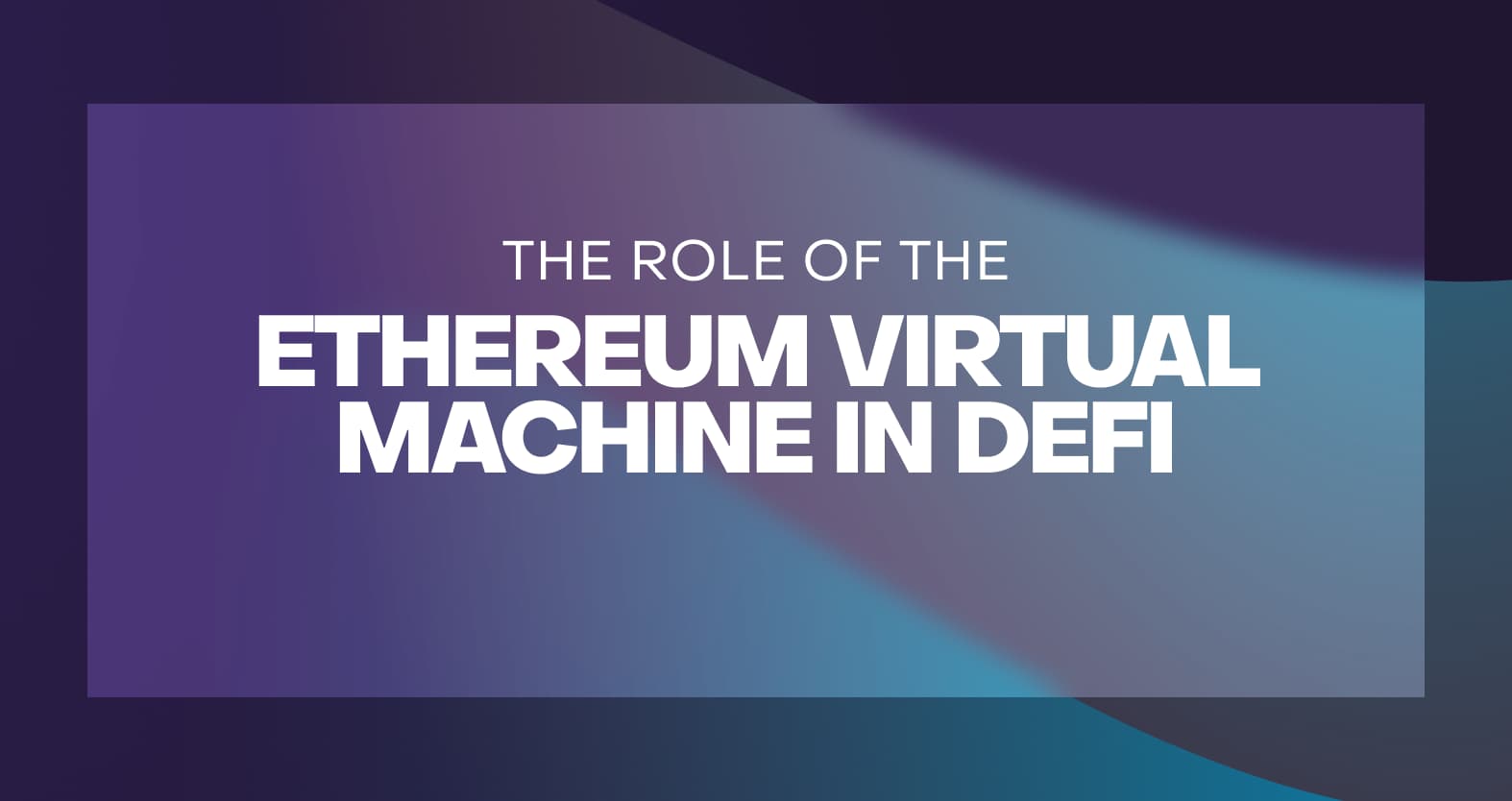
Table of contents
- What is EVM?
- What is a Virtual Machine?
- What is Turing-Completeness?
- What Is the Purpose of the Ethereum Virtual Machine?
- Features of the Ethereum Virtual Machine
- Benefits of the Ethereum Virtual Machine
- Disadvantages of the Ethereum Virtual Machine
- EVM’s Role in DeFi
- AtomicDEX — Store and Trade EVM-Compatible Cryptocurrencies
Table of contents
- What is EVM?
- What is a Virtual Machine?
- What is Turing-Completeness?
- What Is the Purpose of the Ethereum Virtual Machine?
- Features of the Ethereum Virtual Machine
- Benefits of the Ethereum Virtual Machine
- Disadvantages of the Ethereum Virtual Machine
- EVM’s Role in DeFi
- AtomicDEX — Store and Trade EVM-Compatible Cryptocurrencies
Ether is one of the largest assets in the crypto market, surpassed only by Bitcoin. The Ethereum network hosts the Ether token and simultaneously serves as a framework that supports several other blockchains and decentralized networks.
Ethereum is essentially an incubation ground for smart contracts that serve different purposes. The Ethereum Virtual Machine (EVM) is the network’s springboard that makes smart contract creation possible.
Key Takeaways
- EVM powers interactions with the Ethereum network, supporting DeFi 2.0 protocols and decentralized applications.
- EVM is deterministic and guarantees the proper response to specific inputs.
- Problems with scalability and gas fees might affect widespread adoption of the Ethereum blockchain as well as cryptocurrencies like ETH and ERC-20 tokens. However, other blockchains with lower gas fees have also adopted EVM as a standard for smart contracts.
What is EVM?
The Ethereum Virtual Machine is the software that platform developers use to launch smart contracts and design decentralized applications (dApps) on the Ethereum blockchain as well as other blockchains like BNB Chain and Avalanche. It's an engine that functions as a decentralized computer host for millions of nodes and related projects.
EVM is a virtual machine that carries the entire weight of the Ethereum infrastructure. It simplifies the creation and floating process for developers so that there is no need to invest in heavy and expensive hardware to function on the blockchain. A complete understanding of the Ethereum Virtual Machine requires some knowledge of virtual and Turing-complete machines.
What is a Virtual Machine?
A virtual machine (VM) is a system that functions at a level of abstraction higher than traditional operating systems. Although virtual machines require these conventional operating systems and have functions similar to a physical computer, they provide additional computing power on a higher level. Virtual machines improve network processing and creation speeds by pooling resources supplied by network participants. Developers can utilize aggregate computing power, regardless of physical location, to build and launch applications. The Ethereum Virtual Machine (EVM) is mainly considered a Turing-complete machine. However, there are arguments that state gas-fee limitations act as an impediment to the EVM’s Turing-complete status.
What is Turing-Completeness?
A Turing-complete system can effectively simulate or compute any other language or system. With the required instructions, time, and memory, a Turing-complete system can solve any computational problem, no matter how difficult or complex. The Ethereum network is considered Turing-complete because it can process and implement all types of computations, whether they are available or yet to exist. This concept is named after acclaimed mathematician and computer scientist Alan Turing.
What Is the Purpose of the Ethereum Virtual Machine?
The Ethereum Virtual Machine has multiple functions.
Firstly, it serves as the primary framework that accommodates all smart contracts powering blockchains and decentralized applications built on the Ethereum blockchain. The EVM also helps blockchains communicate with each other. Networks like BNB Chain, Cronos, and Polygon are examples of blockchains with EVM compatibility, forming an integral framework for the decentralized finance (DeFi) sector.
If the EVM or a similar virtual machine didn't exist, developers and other blockchain programmers would have to create multiple softwares for each operating system.
Features of the Ethereum Virtual Machine
Several features make the Ethereum Virtual Machine function. Some of them include:
- Distributed State Machine: A distributed state is a network of computers that functions as interconnected servers and workstations. On the other hand, a distributed state machine operates a distributed state with multiple nodes that maintain, manage, and share data when needed.
- Smart Contracts: Developers can design and deploy smart contracts on the Ethereum Virtual Machine to power other services and decentralized applications.
- Deterministic: A deterministic program always produces the same output in response to a specific input. This concept helps developers create programs that will demonstrate results that tally specific inputs regardless of frequency or number of users.
- Terminable: A terminable system can shut down operations at specific times. Although the EVM is Turing-complete, Ethereum transactions generally depend on gas fees. The network can terminate transactions if the paid gas fee runs out.
- EVM Compatibility: This allows creators on other blockchains to build Ethereum-supported apps. Since the EVM creates an interoperable environment, developers can build protocols and other solutions faster, reducing the time it takes to deploy on the blockchain instead of starting from scratch.
Benefits of the Ethereum Virtual Machine
- DApp Development: A major benefit of EVM is that all developers have a ready-made platform to create their own decentralized applications. EVM also supports creating and deploying non-fungible tokens (NFTs), which gives creators control over digital art and other assets an NFT can represent. This uniqueness democratizes the crypto and NFT ecosystem.
- Security: Decentralized applications that are EVM-compatible already enjoy some level of security based on the EVM’s inherent features. This opens the entire ecosystem to more flexibility if security is one less thing for developers to worry about.
- Isolated Design: The EVM enjoys isolation from all the DApps it hosts. The EVM remains immune and untouched if any of these products suffer breaches, malware, bugs, or points of failure (POF).
Disadvantages of the Ethereum Virtual Machine
- Partial Decentralization: Although Ethereum is a decentralized network, many nodes on the network are powered by centralized systems such as Amazon Web Services (AWS). Undue control or points of failure on AWS could have damaging effects on the network.
- Technical Knowledge: Extensive use of the EVM requires techical know-how. Although a few user-friendly platforms help - especially with NFTs - most interactions with the EVM might be difficult for the average person.
EVM’s Role in DeFi
The Ethereum Virtual Machine is an essential part of the decentralized finance industry. Progress in the sector requires a lot of effort from developers who can create decentralized applications that tackle problems caused by centralized finance.
Essentially, the EVM provides all stakeholders with the perfect playing ground to provide protocols and solutions that solve problems with traditional finance, while also helping developers create applications tailored to specific decentralized financial needs.
The Ethereum Virtual Machine is the nucleus that powers operations on the Ethereum network. All Ethereum applications and solutions enjoyed by today’s decentralized community might not exist without some connection to the network through the EVM. More than just the Ethereum network, the EVM is also integral to decentralized finance across various blockchain ecosystems as a whole.
AtomicDEX — Store and Trade EVM-Compatible Cryptocurrencies
Try AtomicDEX — Komodo's flagship application. AtomicDEX is a non-custodial multi-coin wallet and cross-chain/cross-protocol decentralized exchange rolled into one app.
AtomicDEX supports numerous EVM-compatible blockchains and their cryptocurrencies. This includes ETH and all ERC-20 tokens, BNB and all BEP-20 tokens, MATIC, AVAX, and much more.




